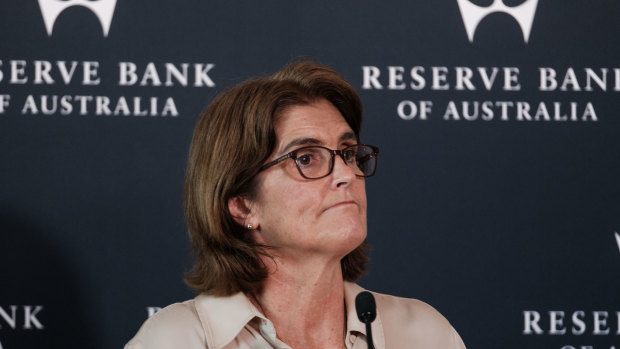- Analysis
- Politics
- Federal
- Interest rates
This was published 1 year ago
Six little words that give hope to Australia’s mortgage holders
By Shane Wright
A six-word change in Reserve Bank language has given hard-pressed home buyers, struggling businesses and distressed renters a crack of hope.
Six weeks ago, as cashed-up Taylor Swift fans splashing out on expensive tote bags prompted fears that excess spending would fuel inflation, the bank warned that “a further increase in interest rates cannot be ruled out”.

A little ray of sunshine has been offered by Michele Bullock to borrowers.Credit: Oscar Colman
It came as a surprise to economists and analysts as many believed there was enough evidence to show inflation was coming down faster than expected and that the economy was already labouring under the RBA’s rate hikes of 2023.
RBA governor Michele Bullock used her first press conference in charge of the institution to argue “we have maintained the option that it might be that there has to be more rate rises”.
Six weeks on, Swifties are at home watching re-runs of The Eras Tour on Disney+, saving every cent for a copy of The Tortured Poets Department. And the Reserve Bank now says that when it comes to interest rates, it is “not ruling anything in or out”.
Gone is an explicit suggestion that the next move could be up. By not ruling anything in or out, the bank has actually given itself the cover to start considering a rate cut later this year.
Bullock admitted that the language had changed “in response to some data”.
The only data of note since her first press conference has been monthly inflation, which showed price pressures easing faster than forecast, employment figures revealing an unexpected uptick in unemployment, and the national accounts, which confirmed an economy a couple of boatloads of iron ore away from contracting.
But the statement also contained some important economic breadcrumbs. The most important was around wages growth, which the bank thinks has now peaked.
Pushed during her press conference about whether a planned jump in pay for aged care workers could keep inflation high, Bullock sounded human as she noted it was unlikely to cause a difference to the bank’s own forecasts while adding, “I think it’s a very worthy pay rise” for a group of traditionally underpaid people.
The bank also noted the bleeding obvious, saying growth was slowing, that household consumption was “particularly weak”, while there has been a much-needed lift in productivity.
The other impression left by the bank, which goes to show it is in the midst of a shift from a rate-hike mentality to a rate-cut headspace, is its clear uncertainty. In its February statement, uncertainty was referenced five times, but that climbed to seven this month.
That uncertainty is apparent in how it manages to argue there is “continuing excess demand” in the economy. Yet household spending by its own admission is weak, economic growth has slowed every quarter over the past year, and on a per capita basis, the country’s been in a recession since the middle of 2023.
By the time the RBA board next meets on May 6, it will have monthly and quarterly inflation reads plus two reports on the health of the jobs market. Any or all of them could be the catalyst for the bank to rethink its position.
The statement after the May board meeting may have to change a lot more words.
Cut through the noise of federal politics with news, views and expert analysis. Subscribers can sign up to our weekly Inside Politics newsletter.